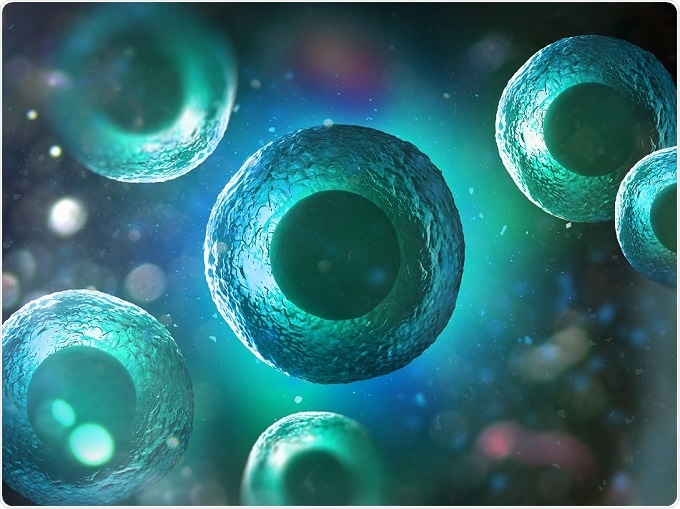
An interview with Prof. Manfred Radmacher, Universität Bremen conducted by April Cashin-Garbutt, MA (Cantab).
Can you please give a brief history of the use of AFM to study cell mechanics in order to understand the biophysical processes of the cells?
Cell mechanics was already of interest very early on to people who were using the AFM. The AFM was invented in 1986 and the first biological samples, both proteins and lipid molecules, were investigated around 1989 and the first time cells were investigated was around 1990.
 © Andrii Vodolazhskyi/Shutterstock.com
© Andrii Vodolazhskyi/Shutterstock.com
It was obvious from the beginning that the main advantage of AFM, compared to the scanning tunneling microscope, which had been invented a couple of years before the AFM by the same group of people, was that you could look at biological samples in physiological conditions, in a liquid environment.
Once you start that, you want to play around and look at all biological samples; not only molecules, but also larger compartments, viruses, cells and so on. The first biological applications were already looking into cells very early on.
When was AFM first used to map elastic modulus across single cells (Force Volume Mode)?
I think that was also around 1993/1994. The first measurements of the elastic properties of biological samples were carried out in Paul Hansma's lab, by Albrecht Weisenhorn, probably around 1993/92. We also started doing that in about 1994 in Munich, in a cooperation with Paul Hansma.
Can you please outline your current research and the application of AFM to study the viscoelastic properties of cells?
My current interest remains the mechanical properties of cells, although the focus has changed a lot. The focus in the early days was on the fact that we had a newly developed instrument, the Atomic Force Microscope. As physicists, we were just curious about using that instrument and applying it to several samples to understand something about the biophysics of cells.
What happened 5-10 years ago, is that when people figured out that by looking at the mechanical properties, you can distinguish between different types of cells. What is prominent is that when looking at diseased cells versus normal cells, or cancer cells versus normal cells, you can use the mechanical properties as a fingerprint or mechanical assay to determine the state of the cells.
What do you think the future holds for the use of AFM in the investigation of biological and biophysical processes?
In the early days, people liked that with AFM, you had a high-resolution microscope, which gave you topographical information about live biological samples, for instance. The resolution was not as good as with the scanning electron microscope, but to use the scanning electron microscope, a lot of sample preparation was required and the samples and cells are also dead.
It looks like the newest applications in other fields − high resolution optical microscopy − will eventually win the race in terms of resolution. The outstanding feature of the AFM is no longer high-resolution images of biological samples. What still makes the AFM unique is its capability in measuring and applying forces to the sample.
One application is the mechanical properties of cells. Other applications would be looking at specific binding forces between molecules. There is no other technique, or only a few other techniques, that allow you to probe at the small scale and with high lateral resolution, these two properties − how molecules interact with each other and what the mechanical properties of the ultra-soft biological samples are. I think this will remain the outstanding feature of the AFM.
What is the biggest impact that AFM has made to the biological and nanomedicine research fields?
Nanomedicine is complicated because AFM is still a technique that is used in a research environment. We are thinking and talking a lot about biomedical applications, but there is no true biomedical application. There is no medical assay used in a clinic. We are envisioning, for instance, that mechanical properties may result in a biomedical assay, but this hasn't happened yet. It will also require different types of instruments.
Now, atomic force microscopes are instruments used in the research environment by highly trained people, Ph.D. students. This is not the type of instrument which will be used in a clinical environment. Therefore, what is going on right now is that people are learning and understanding the instrument. The second step that will be needed, is simplifying it so that it can be used as a routine instrument by technicians, for instance.
How has Bruker technology helped or advanced AFM in biological research?
The first commercial AFMs were been built and sold by a company called Digital Instruments, which became Veeco and eventually became part of Bruker.
The result was that it could be used by a diverse group of people from different backgrounds; not only those from an instrumentational physics or engineering background, but also people from a biological or medical background. I think the fact that it could be applied and used by different people has been very important.
What is the importance of meetings, like the AFM BioMed Conference, to you and the AFM research community?
As with any meeting, they are very important to scientists, because you exchange and discuss your results with colleagues. A conference like this one has some history and I think this is the 8th conference now. A conference like that brings the same type and same groups of people together on a regular basis, meaning you can really discuss your results.
One part of the conference is the presentations you hear in the lecture hall, but the more important part is what is happening here in the hallway − people are really discussing the results. This is the benefit of a small, close community that meets regularly and critically discusses their own results in a very open way.
What direction do you see, or would like to see, AFM going in the next five years? (What do you see as the next big thing for AFM?)
I would like to see a simplified instrument developed as an offspring of the AFM, that enables mechanical measurements on cells or, even better, on tissues and that could eventually be used in the clinical environment.
I doubt that five years is the appropriate time frame for this. AFM has been used very successfully in a research environment, but I think it would be a real jump to a new universe or a new world, if we could extend the applications to a clinical/medical field.
How long do you think it will take?
Let us meet in five years and discuss that question again. It may be ten years, but it is hard to make any hypothesis here!
Where can readers find more information?

About Prof. Manfred Radmacher
Prof. Dr. Manfred Radmacher is professor for Biophysics at the University of Bremen. Dr. Radmacher undertook his PhD Thesis at the Physics Department, Institute for Biophysics, Technical University Munich. He holds degrees in Abitur, Diploma in Physics, PhD in Physics and Habilitation (venia legendi) in Experimental Physics.